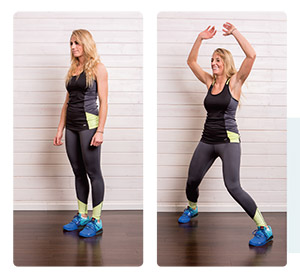
Did you know that exercise can help prevent cancer? Exercise can actually counteract DNA damage by reducing oxidative stress and aiding DNA repair. Is it worth spending 10 minutes a day to lower your cancer risk? Then try this 10-minute, no excuses workout.
By 2030, cancer cases are estimated to rise by 40 percent in Canada. Yet half of these cases can be prevented with proper screening and healthy habits. It’s not only what you eat; exercise has powerful cancer-fighting benefits too. Learn how a simple exercise plan can help reduce your risk.
Exercise and cancer
Envision exercise as a natural pill. In essence, it’s a cancer-fighting pill that alters hormones, eliminates carcinogenic waste, and suppresses cancer-causing genes.
As with any pill, our dose response varies. That is, the benefits of exercise change depending on the frequency and intensity of our physical activity. It affects each type of cancer differently, so while there is an undeniable benefit, the risk reduction varies.
Colorectal, breast, and lung cancer are some of the most likely to affect us, and they account for more than half of all newly diagnosed cases. Yet research shows a strong association between exercise and risk reduction for these cancers.
Colorectal cancer
Colorectal cancer affects the colon and rectum, which are parts of the digestive system. It is the second most likely cause of death in men and the third most likely in women, but this statistic is strongly linked to modifiable risk factors such as inactivity.
How does exercise help?
By reducing sedentary lifestyle habits and adding an exercise program, we can reduce our risk of colon cancer by 30 to 40 percent depending on our frequency and duration of physical activity.
Many of us have experienced firsthand the cancer-fighting effects of exercise. As your heart rate increases and your muscles begin to contract, so do your intestines. This wavelike contraction, known as peristalsis, may cause your stomach to rumble and create a sudden urge to use the washroom.
Exercise reduces the time we’re exposed to potential carcinogenic waste by promoting peristalsis. This inhibits the growth of cancer cells and reduces intestinal inflammation. Our body’s energy system is able to regain balance and reduce our risk of cancer.
Breast cancer
Two out of three breast cancer cases are directly linked to the quantity of sex hormones circulating in the body. While estrogen is essential for healthy cell growth, high lifelong exposure can cause rapid cell division that may lead to cancer cell mutation.
How does exercise help?
The benefits of physical activity include decreasing sex hormones such as estrogen. Studies have shown that physically active women can reduce their risk by 20 to 40 percent. This includes postmenopausal women who don’t produce as much overall estrogen but continue to produce localized estrogen in fat tissue.
Of course, exercise also helps us maintain a healthy weight. With less body fat, there is lower production of estrogen in fat cells. Plus, a healthy weight balances insulin levels and reduces internal inflammation, which may also reduce breast cancer risk.
Lung cancer
Lung cancer has the highest mortality rate worldwide. Encouragingly, physical activity can reduce our risk by as much as 50 percent in men and 30 percent in women.
Our lungs are easily damaged by environmental toxins such as pollution, dust, and cigarette smoke. This causes the body to create unstable molecules known as reactive oxygen species (ROS). These molecules damage DNA, suppress the immune system, and increase inflammation—which can then initiate cancer growth.
How does exercise help?
Exercise counteracts DNA damage by reducing oxidative stress and enhancing DNA repair. Other benefits of physical activity include a reduction of inflammation in lung tissue and simultaneously an increase in immune function, which helps combat and destroy rogue cancer cells.
How much exercise is enough?
Now that we understand the profound role exercise plays in reducing our risk of certain cancers, how much should we do?
Evidence strongly suggests at least 30 to 60 minutes of moderate intensity activity (when it’s slightly difficult to catch your breath) or vigorous intensity activity (when you’re huffing and puffing) at least five days a week. If you’re brand new to exercise, start slowly. A brisk 30-minute walk is enough for you to enter the moderate intensity zone and benefit from reduced cancer risk.
Generally, the more you exercise, the greater the benefit. For example, a trend analysis found an additional 6 percent decrease in breast cancer risk for each extra hour of exercise performed per week. This doesn’t mean you have to spend all day exercising. It simply means you’re more likely to reach the upper risk reduction levels by choosing a bit more than the minimum 30 minutes required.
Consistency is key
A lifetime of regular exercise provides the greatest protective benefits, so find an activity that you know you’ll stick with long term. Dedicate a specific time in your schedule to a cancer-combatting fitness routine. Join a class, go for walks with a friend, or do quick 10-minute workouts to eliminate all obstacles that could stop you from staying active.
Daily activities as exercise
Your body doesn’t know the difference between a structured exercise program and normal movement at a faster pace. Take advantage of this by using daily activities to achieve the same benefits exercise brings.
| Moderate intensity | Vigorous intensity |
| walking briskly | climbing stairs or walking uphill |
| gardening: weeding, sowing seeds, watering, and planting transplants | gardening: digging, shovelling, raking |
| walking your pet | hiking |
| cleaning: washing windows, vacuuming, mopping | moving furniture or carrying heavy loads (greater than 44 lbs or 20 kg) |
| pushing a motorized lawn mower | pushing a non-motorized lawn mower |
The 10-minute, no-excuses workout
Sometimes life is too busy to find 30 to 60 free minutes per day. Instead, try breaking up your workout into three 10-minute bursts of moderate physical activity.
This moderate intensity workout is known as a circuit. Perform each activity for one minute and then immediately begin the next. Do this circuit twice to successfully accumulate 10 minutes of exercise.
Knee-High Run (or Walk)
- Begin in a standing position with feet shoulder-width apart and hands by your sides.
- Contract your stomach muscles as you lift one knee up to your waist.
- Switch knees. Keep weight on the ball of your foot.
- Swing your arms, keeping them bent at a 90-degree angle as you switch knees.
For more intensity
To modify, switch knees quickly so that you’re running with knees high.
Run (or Walk) on the Spot
- Begin in a standing position with feet shoulder-width apart and hands by your sides.
- Run or walk on the spot. Keep weight on the balls of your feet.
- Swing your arms, keeping them bent at a 90-degree angle.
- Keep your stomach contracted and head facing forward.
Jumping Jacks
- Stand with your feet together and arms by your sides, palms against thighs.
- Jump your feet to the sides and simultaneously raise your arms above your head.
- Immediately jump back to starting position.
Hops and Squats
- Stand with your feet shoulder-width apart and hands on hips.
- Bend your knees. Keep your torso tall as you squat down.
- Jump up, then immediately squat back down.
For bad knees and beginners
To modify, skip the hop. Simply stand up after you bend your knees and squat down.

Heel Kicks
- Stand with your feet together, hands on hips, and torso tall.
- Bend your left knee and leg so left heel touches your bottom.
- Quickly switch legs. Bend your right knee and leg so right heel touches your bottom.
- Repeat as quickly as possible while maintaining proper form.








































